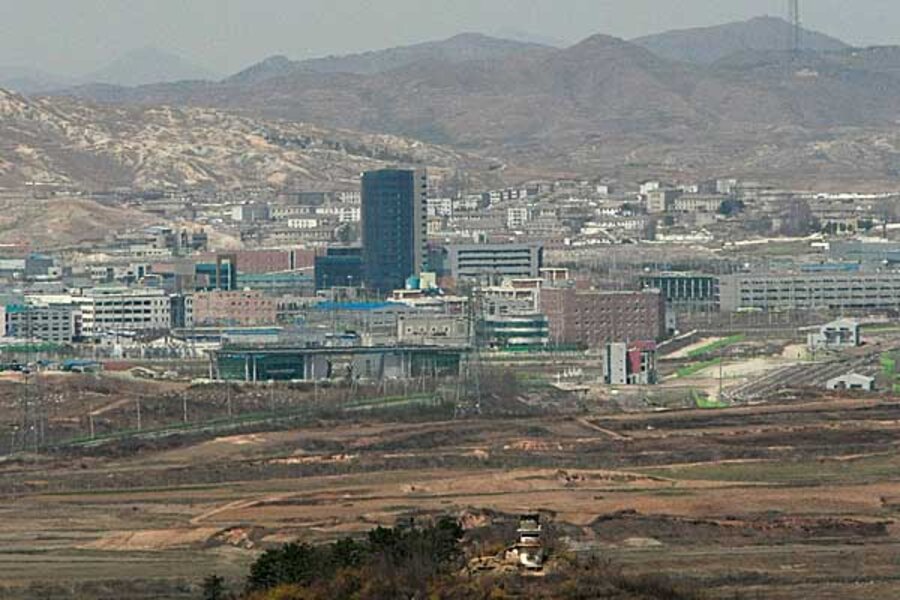North Korea moves to cut remaining ties with South
Loading...
| Seoul, South Korea
North Korea appears on the verge of shutting down the last remaining point of contact between the two Koreas – the Kaesong Economic Complex, long seen as a beacon of hope for North Korea’s dilapidated economy and a symbol of the potential for North-South cooperation.
That’s the implication of a report late Tuesday by Pyongyang’s Korean Central News Agency that the North is expelling all South Koreans from the complex, where more than 100 South Korean factories turn out light industrial products. The South Koreans are technicians and managers responsible for directing more than 40,000 North Korean workers on assembly lines.
The North Korean report said relations with South Korea would be “severed” and “all communications links between the north and south will be cut off,” ending the dream of North-South cooperation at Kaesong.
'Smear campaign'
North Korea accused the South of waging a “smear campaign” – a reference to South Korea’s charge that a North Korean submarine fired the torpedo that sunk the Cheonan, a Korean Navy corvette, in March, killing 46 sailors. South Korea is calling for strengthened UN sanctions against North Korea based on a lengthy investigation by a team that included 10 foreign experts.
It was not clear, though, if the ban on all communications will extend to the truce village of Panmunjom, adjacent to Kaesong, where North and South Korean soldiers face each other across the North-South line in a joint security area that’s become a destination for tourists from both sides.
A small number of US troops also mans the southern side of the line at Panmunjom, where officers meet occasionally under terms of the truce that ended the Korean War in 1953 to talk over pressing problems and are able to get in touch on a special phone line.
Suspension of operations at Kaesong would mark a final blow to the economic gains of years of reconciliation on the Korean peninsula. North Korea has been earning about $50 million a year from the complex, mostly from salaries paid by the South Korean companies as wages to the workers, who South Korean officials privately acknowledge never actually get the money.
South Korea’s President Lee Myung-bak suspended all trade and most aid with North Korea on Monday, but did not stop production at Kaesong, located just above the North-South Korean line and about 40 miles north of Seoul.
Propaganda time
North Korea made the announcement as South Korea was again broadcasting propaganda messages into North Korea. South Korea resumed propaganda broadcasts Tuesday while refurbishing huge loudspeakers on the southern side of the Demilitarized Zone that has divided the peninsula since the end of the Korean War.
Mr. Lee added another rhetorical flourish Tuesday by ordering North Korea again to be declared South Korea’s “main enemy” – a term that Kim Dae-jung as president had dropped from Ministry of Defense white papers.
The war of words on both sides escalated as Secretary of State Hillary Clinton was about to leave China and fly here Wednesday for several hours of intense discussion at which she’s certain again to align the US closely with South Korea’s tough position.
North Korea now is accusing South Korean vessels, on increased patrols, of entering North Korean waters, and is threatening to fire on them. North Korea has also threatened to shoot at the loudspeakers spewing out appeals to North Korean troops on the other side of the DMZ to defect to the South. South Korean leaders are planning joint exercises with US aircraft and warships to sharpen antisubmarine warfare skills in the area in the Yellow, or West, Sea where the Cheonan went down.
“They just want to threaten South Korea, to show they have the capability to harm the South,” says Ha Tae-keung, president of Open Radio for North Korea, broadcasting news and propaganda into the North. “If South Korea succumbs to the threat, they can have the advantage and financial profits from aid.”
Both sides stopped propaganda broadcasts during the decade of the Sunshine policy initiated by the late President Kim in 1998, but the conservative President Lee has declared an end to efforts at reconciliation with the North as tensions rise to the highest level on the peninsula in decades. He took office in February 2008 after winning a landslide victory over a liberal opponent in revulsion over the economic issues as well as disappointment over Sunshine.
Related:





